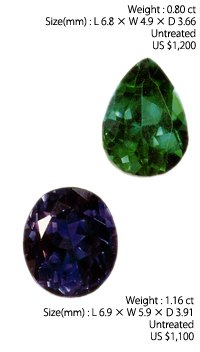VARIETIES OF ZOISITE
East Africa is the current source of tanzanite. Most tanzanite rough is heat treated to remove a yellowish or brownish color and bring out the blue. However, not all tanzanites become the same shade when heated. The differences in each rough crystal’s composition result in different colors, just as in the case of sapphire or aquamarine. Here we will discuss unheated blue and green material, as well as heated blue material. |
 |
Tanzanite (Heated)
This is a typical heat-treated tanzanite, cut in an unusual style called a checkerboard cut. The term “cut” refers to many different aspects: shape, face-up outline, proportions, finish, and the arrangement of facets, such as this checkerboard style. This stone would accurately be called an “oval-shaped checkerboard-cut” tanzanite. |
|
Green Zoisite(Untreated)
The term “green tanzanite” is a misnomer, because tanzanite is a trade name reserved for only the blue gem variety of zoisite. Nomenclature is an important factor influencing the desirability of a product, and while the name “zoisite” may seem a little formal, the word “tanzanite” has enjoyed great success as a trade name due to the aura of mystique that surrounds it. Regardless, the availability of green zoisite is extremely limited and the possibility of it becoming a commercial product appears to be very slim. |

|
Tanzanite (Untreated)
This naturally blue zoisite contains inclusions that are nearly invisible to the unaided eye. At magnification of 10 times, one can barely make out a black fragment near the surface at the edge of the table and reflective fracture directly beneath the table. The blue color and tone of 5 make these even less apparent. Other than surface-reaching fractures, inclusions that are invisible to the unaided eye have little effect on value. This is because while transparency or saturation levels clearly affect beauty, inclusions that cannot be seen without magnification do not lessen the attractiveness of a stone. |
|
JUDGING QUALITY
Tanzanites with a deep color and a high level of transparency are considered attractive. In particular, stones with weaker pleochroism that resemble sapphires are given a beauty grade of S. A tanzanite with a sapphire-blue color under indirect sunlight will take on a purplish hue under incandescent light. Stones in which the degree of change is small are considered S, while stones that change distinctly are assigned a beauty grade of A.
In the West, stones with weaker pleochroism are preferred, but in Japan there are cases where the pleochroism is preferred as a characteristic trait of tanzanite. Since tanzanaite is not a substitute for sapphire, perhaps this property should be appreciated as part of the character of the gemstone. Visible pleochroism is determined to a large degree by the angles used at the time of fashioning, and polishing styles will probably settle into those that are considered optimum based in what is in demand. Finally, because tanzanite is a soft gemstone and the finish is often abraded, finish is given special attention when assigning the beauty grade.
|
|